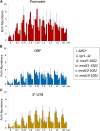Role of Mediator in regulating Pol II elongation and nucleosome displacement in Saccharomyces cerevisiae
- PMID: 22377631
- PMCID: PMC3338273
- DOI: 10.1534/genetics.111.135806
Role of Mediator in regulating Pol II elongation and nucleosome displacement in Saccharomyces cerevisiae
Abstract
Mediator is a modular multisubunit complex that functions as a critical coregulator of RNA polymerase II (Pol II) transcription. While it is well accepted that Mediator plays important roles in the assembly and function of the preinitiation complex (PIC), less is known of its potential roles in regulating downstream steps of the transcription cycle. Here we use a combination of genetic and molecular approaches to investigate Mediator regulation of Pol II elongation in the model eukaryote, Saccharomyces cerevisiae. We find that ewe (expression without heat shock element) mutations in conserved Mediator subunits Med7, Med14, Med19, and Med21-all located within or adjacent to the middle module-severely diminish heat-shock-induced expression of the Hsf1-regulated HSP82 gene. Interestingly, these mutations do not impede Pol II recruitment to the gene's promoter but instead impair its transit through the coding region. This implies that a normal function of Mediator is to regulate a postinitiation step at HSP82. In addition, displacement of histones from promoter and coding regions, a hallmark of activated heat-shock genes, is significantly impaired in the med14 and med21 mutants. Suggestive of a more general role, ewe mutations confer hypersensitivity to the anti-elongation drug 6-azauracil (6-AU) and one of them-med21-impairs Pol II processivity on a GAL1-regulated reporter gene. Taken together, our results suggest that yeast Mediator, acting principally through its middle module, can regulate Pol II elongation at both heat-shock and non-heat-shock genes.
Figures






Similar articles
-
Mediator, TATA-binding protein, and RNA polymerase II contribute to low histone occupancy at active gene promoters in yeast.J Biol Chem. 2014 May 23;289(21):14981-95. doi: 10.1074/jbc.M113.529354. Epub 2014 Apr 11. J Biol Chem. 2014. PMID: 24727477 Free PMC article.
-
Role for the MED21-MED7 Hinge in Assembly of the Mediator-RNA Polymerase II Holoenzyme.J Biol Chem. 2016 Dec 23;291(52):26886-26898. doi: 10.1074/jbc.M116.756098. Epub 2016 Nov 7. J Biol Chem. 2016. PMID: 27821593 Free PMC article.
-
Mediator recruitment to heat shock genes requires dual Hsf1 activation domains and mediator tail subunits Med15 and Med16.J Biol Chem. 2013 Apr 26;288(17):12197-213. doi: 10.1074/jbc.M112.449553. Epub 2013 Feb 27. J Biol Chem. 2013. PMID: 23447536 Free PMC article.
-
Origins and activity of the Mediator complex.Semin Cell Dev Biol. 2011 Sep;22(7):729-34. doi: 10.1016/j.semcdb.2011.07.021. Epub 2011 Jul 28. Semin Cell Dev Biol. 2011. PMID: 21821140 Free PMC article. Review.
-
The Mediator complex and transcription regulation.Crit Rev Biochem Mol Biol. 2013 Nov-Dec;48(6):575-608. doi: 10.3109/10409238.2013.840259. Epub 2013 Oct 3. Crit Rev Biochem Mol Biol. 2013. PMID: 24088064 Free PMC article. Review.
Cited by
-
Knockdown of mediator subunit Med19 suppresses bladder cancer cell proliferation and migration by downregulating Wnt/β-catenin signalling pathway.J Cell Mol Med. 2017 Dec;21(12):3254-3263. doi: 10.1111/jcmm.13229. Epub 2017 Jun 19. J Cell Mol Med. 2017. PMID: 28631286 Free PMC article.
-
Mediator recruits the cohesin loader Scc2 to RNA Pol II-transcribed genes and promotes sister chromatid cohesion.Curr Biol. 2022 Jul 11;32(13):2884-2896.e6. doi: 10.1016/j.cub.2022.05.019. Epub 2022 Jun 1. Curr Biol. 2022. PMID: 35654035 Free PMC article.
-
CgMED3 Changes Membrane Sterol Composition To Help Candida glabrata Tolerate Low-pH Stress.Appl Environ Microbiol. 2017 Aug 17;83(17):e00972-17. doi: 10.1128/AEM.00972-17. Print 2017 Sep 1. Appl Environ Microbiol. 2017. PMID: 28667115 Free PMC article.
-
Evidence for Multiple Mediator Complexes in Yeast Independently Recruited by Activated Heat Shock Factor.Mol Cell Biol. 2016 Jun 29;36(14):1943-60. doi: 10.1128/MCB.00005-16. Print 2016 Jul 15. Mol Cell Biol. 2016. PMID: 27185874 Free PMC article.
-
Proteomic Analysis of the Mediator Complex Interactome in Saccharomyces cerevisiae.Sci Rep. 2017 Feb 27;7:43584. doi: 10.1038/srep43584. Sci Rep. 2017. PMID: 28240253 Free PMC article.
References
-
- Adkins M. W., Howar S. R., Tyler J. K., 2004. Chromatin disassembly mediated by the histone chaperone Asf1 is essential for transcriptional activation of the yeast PHO5 and PHO8 genes. Mol. Cell 14: 657–666. - PubMed
-
- Apone L. M., Virbasius C. A., Holstege F. C. P., Wang J., Young R. A., et al. , 1998. Broad, but not universal, transcriptional requirement for yTAFII17, a histone H3-like TAFII present in TFIID and SAGA. Mol. Cell 2: 653–661. - PubMed
-
- Ardehali M. B., Lis J. T., 2009. Tracking rates of transcription and splicing in vivo. Nat. Struct. Mol. Biol. 16: 1123–1124. - PubMed
-
- Baidoobonso S. M., Guidi B. W., Myers L. C., 2007. Med19(Rox3) regulates intermodule interactions in the Saccharomyces cerevisiae Mediator complex. J. Biol. Chem. 282: 5551–5559. - PubMed
MeSH terms
Substances
LinkOut - more resources
Full Text Sources
Other Literature Sources
Molecular Biology Databases
Research Materials

